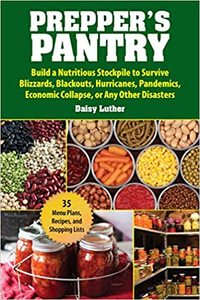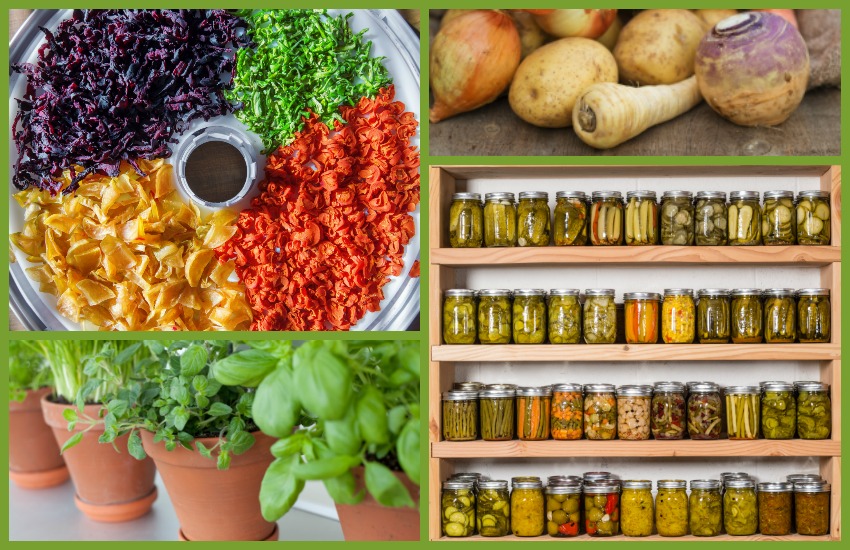If you're new here, you may want to subscribe to my RSS feed. Thanks for visiting!
By the author of Be Ready for Anything and the online course Bloom Where You’re Planted
Most people who are working hard to eat well consume a lot of fruits and vegetables. One of the biggest issues folks are noticing with the Stockpile Challenge is getting enough produce in their diets.
It can be a major challenge when living from your stockpiled foods to get enough fruits and vegetables. This is dangerous because, without produce, your family can be at risk for nutritional deficiency diseases like scurvy and their immune systems will be compromised. A minimum of 5 servings per day is recommended, but during the long winter, how can you meet that goal with the contents of your pantry?
As well, many people these days generally eat a low-carb diet that is reliant on protein and produce. (You can get more info about stockpiling for a low-carb diet here.)
Supplying your family with produce that will provide the necessary nutrients that their bodies need to thrive is a twofold process. Not only should you preserve the summer’s bounty for the winter ahead, but you should also come up with ways to add fresh greens outside of the growing season. (Get a free full-color guide to building a 3-Layer prepper’s pantry here.)
Building a Stockpile of Fruits and Vegetables
When creating your produce stockpile, you have to look at what actually constitutes a “serving” for the people you will be feeding. It may not actually be the amount that you expect. For example, a child’s serving of green beans is anywhere from a quarter cup to a half a cup (depending on their age), but an adult’s serving is a full cup. So for a child, plan on 1-3 cups of produce per day and for an adult, plan on 5 cups of produce per day.
Whenever possible, focus on organic produce. The use of pesticides in conventional farming is rampant. Even the Environmental Protection Agency has to admit that the ingestion of pesticides can cause health problems. They warn of the risk of “birth defects, nerve damage, cancer, and other effects that might occur over a long period of time.” Especially at risk of harm from pesticides are prepubescent children and fetuses.
My family also chooses to avoid GMOs (genetically modified organisms). Particularly avoid anything non-organic that contains corn or soy ingredients. There are questions about health risks and GMOs are engineered to withstand even higher dousing of pesticides than other conventional fruits and veggies.
What to Buy
At the grocery store, look for sales to build your supply of produce:
Dried: Dried fruits such as raisins, banana chips (without sugar), and dried cranberries can pack a lot of nutritional punch into a tiny serving size. Think of them as concentrated vitamins. An adult serving of raisins is only 1/4 cup, which means that you can pack a lot of nutrition into a small amount of space with dried fruits.
Canned: Canned goods such as tomatoes, green beans, and peas can go a long way towards providing nutrition. The benefit to those rows of tin cans is that you don’t require power to store them safely, and they are fully cooked so you don’t even have to heat them up in a grid down situation. You can also find many varieties of canned fruit but beware of heavy syrups. Opt for fruit canned in juice if possible.
Frozen: Frozen fruits and vegetables are the closest to fresh that you can get. This is a great way to build a stockpile for times when money is tight, but don’t put all of your produce in the freezer. During an extended power outage, you stand to lose a large portion of your deep freeze contents. If you do purchase a large amount of produce for the freezer, have canning jars, lids, and an off-grid method for canning them if the electricity goes down for the long-term.
Freeze-dried: This is a more expensive option, but freeze dried fruits and vegetables maintain nutrients, require little storage space, and need no special storage conditions. You can add a great deal of variety to your pantry with a selection of freeze dried ingredients and the foods, if sealed correctly, can last up to 25 years. You can find a wide variety of freeze-dried fruits and vegetables HERE.
Preserving Fruits and Vegetables
There are many effective ways to preserve fruits and vegetables that you acquire fresh. Whether you harvest them from your own property, buy them at the farmer’s market or a local orchard, or even make a bulk purchase from the discount bin at the grocery store, having the supplies and skills to quickly preserve them can allow you to make the most of your windfall. Learn more about the following methods.
- Dehydrating
- Canning
- Root Cellaring – Keep onions, potatoes, parsnips, carrots, apples, and winter squash in a cold room.
- Freeze-Drying – home freeze dryers are becoming very popular – go here for some expert advice
Indoor Gardening
There are all sorts of things you can grow indoors, even in the dead of winter. It helps to have a south-facing window and barring that, a grow light. I have had wonderful luck with spinach, lettuce, herbs, garlic, green onions, and even some teeny little radishes. I know others who have been successful with tomatoes and peppers but I have personally never managed those inside. (Maybe one day I’ll get my dream sunroom!) Some folks keep dwarf citrus trees in their homes, also.
And don’t overlook the value of sprouting. Sprouts grow incredibly quickly. They’re easy to grow and highly nutritious. You can learn absolutely everything you ever wanted to know about sprouting at this website. I like bean sprouts and microgreens the best. Each type of sprout has a very different texture and flavor.
Any tips?
Many in our community are just beginning to build their pantries. Do you have any budget-friendly tips for adding fruits and vegetables to the larder? Please share them in the comments below…
Want to learn more? Check out my book!

Check out Prepper’s Pantry: Build a Nutritious Stockpile to Survive Blizzards, Blackouts, Hurricanes, Pandemics, Economic Collapse, or Any Other Disasters

















remember tha vitamin c is damaged by heat, so canning loses a significant portion of that vitamin. remember also that you should use the water the vegetables and fruits are canned in. water soluble vitamins migrate to that water, so use them to get max benefit from this food.
scurvy takes months to develop, so don’t worry too much if you don’t have vitamin c for a short time, but do take vitamin c supplements if you can’t get the vitamin for a significant period of time.
Canning apples and pears in a light syrup works great. We are eating pears in a light honey syrup that I canned a few years ago and they’re so good. The cheapest pears I could find were .99/lb but they came out great and we are greatful for them. Not sure if they are any cheaper than store bought but I know what’s in them.
We have bought freeze dried fruits and vegetables to get us through when we are unable to grow fresh .
Berry bushes are easy to grow and tend. You can plant them out of the way, in landscaping or along a fence. I do make some jams but frozen is a great way to preserve them. Also look into what kinds of wild edible berries you have in your area, we have blackberries and huckleberries along with Wild muscadines – I harvest them all. Oh and we have wild elderberries but not a lot on our property. We see them wild on the roadsides.
Mrs FP
Pickled vegetables are so high in vinegar (acid) that you can water bath can with a clear conscience. That means, pickles, pickled carrots, pickled beets, pickled onions, pickled asparagus, pickled peppers… you get the picture. For people who either choose not to pressure can or do not have the option to, pickling is a great way to put up more of your produce without worrying about botulism.
For commercial vendors:
Rainy Day is hands down my favorite dehydrated vegetable supplier, partly because of the more unusual produce offered. Dehydrated sweet potatoes? Yes. Celery? Yes. Broccoli? Oh yeah. Mushrooms? Absolutely.
Augason Farms has solid quality and the price is right IF you buy them in local stores like Walmart. They are pretty high if bought from the website. Good source of dehydrated bananas, great granola, peppers, etc.
Emergency Essentials is my least favorite vendor that I still order from, as they offer more freeze dried than dehydrated. I just don’t like freeze dried as much. Still, they do have things like pineapple and peaches which are good.
Don’t forget about lacto-fermentation. You can preserve vitamin content and create beneficial bacteria (plus it’s super yummy if you have, or develop, a taste for it).
Did you mean to put a link in for the book? 🙂
You can find it here folks: https://www.amazon.com/dp/B01GIZN5TS/
We bought a Freeze Dryer about 6 months ago, and are using it to knock down the over supply of meat we had in our two freezers. We felt totally over-exposed in case we ever lost our power for any length of time.
Of course, during the summer and fall, every time something came ripe, it went into the Freeze Dryer, so we did gobs of strawberries, bananas, blueberries, sweet potatoes — you name it.
We’ve got Salmon in there right now.
I also wanted to recommend Costco Kirkland brand dried blueberries and cherries. It’s a good size bag and not badly priced. Today I used some in a large batch of quick oatmeal I made for my daughter, along with brown sugar, cinnamon, vanilla powder and chopped pecans. I’ve made cherry vanilla almond oatmeal with their dried cherries.
I made granola today and instead of raisins, I use a small bag of craisins. Craisins have a good shelf life and come in a variety of flavors.
But I also wanted to mention nutsdotcom as a resource for dried and freeze dried fruit. I bought my elderberries from them – made elderberry syrup last night. They have some interesting items like dried citrus fruits..
Mrs FP
I bought a large 90 serving jar of “red” drink (fruits and berries) and a large 90 serving jar of “green” drink (vegetables). There are lots of brands out there in health food stores and Amazon, so I am not gojng to recommend any one brand. They are practically sugar free which is great for diabetics. It is a reasonable cost and easy way to stock up on berries/fruits/vegetables.
I doubt this comment will ever see light of day, but i just bought a Senzu Knife Sharpener for $13.95 on Amazon with free shipping.
Why wouldn’t it see the light of day?
I love Harvest Right company, but I cannot afford their home freeze dryers. I am still planning to buy a vacuum chamber and pump, and begin each batch in my regular fridge freezer. Harvest Right costs about $2000 for the smallest size. A 3 gallon vacuum chamber with pump can cost $200.
Because freeze drying is such high quality, I want to promote it. Also, it could cut down on food waste, including on-farm food waste, and allow more flavorful produce to be grown, when poor-shipping varieties can be freeze-dried on farm.
I have not chosen a freeze-dryer yet.